Saturday Shoutout / Rosenbauer On The Vise
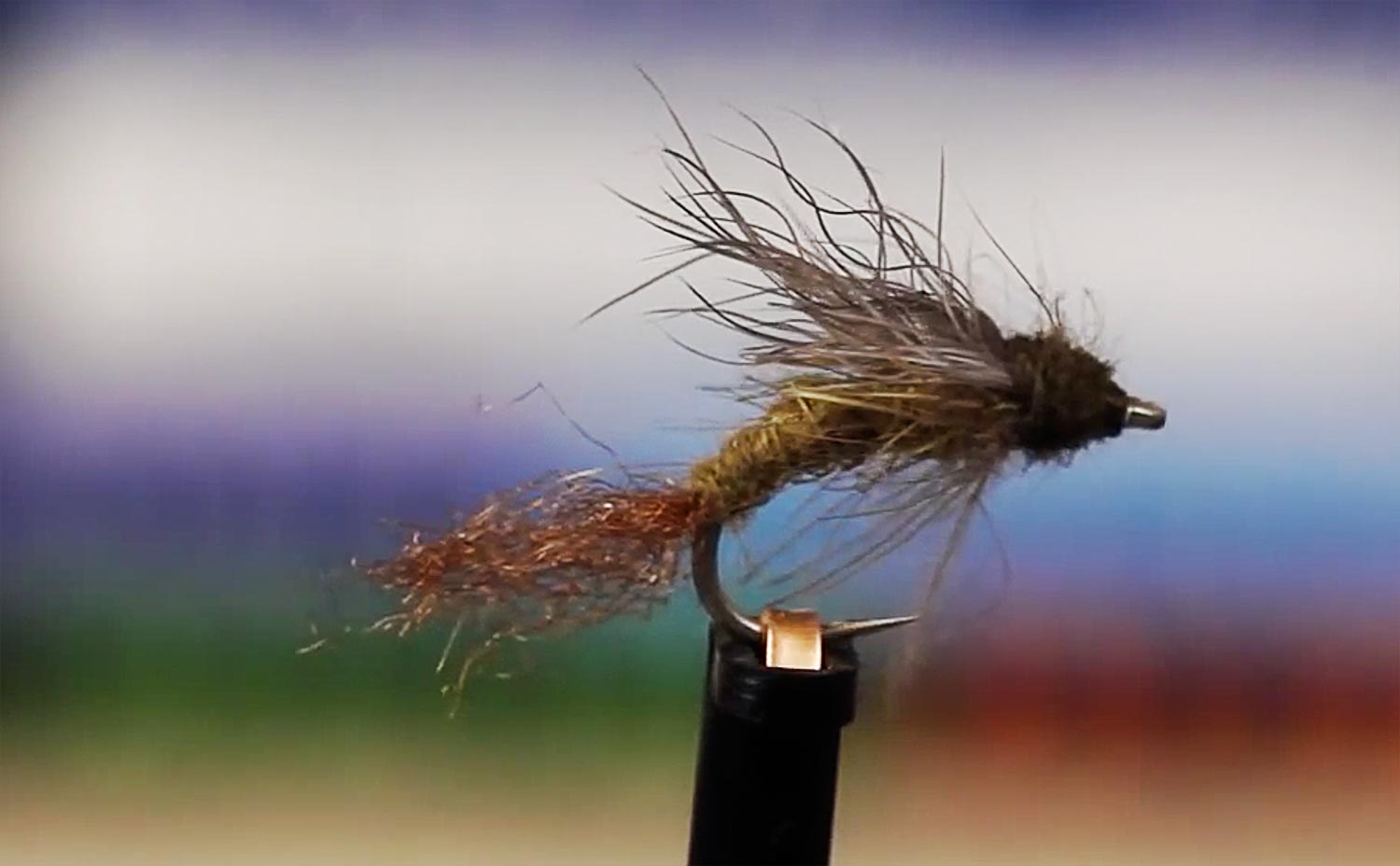
Tom Rosenbauer is a “go big, or go home” kind of guy.
Aside from being a walking encyclopedia of fly fishing, one of the most endearing things about Tom is his witty and self effacing sense of humor. When asked to come up with a video to support the Orvis Giant Fly Sale, Tom took the brunt of the joke.
The first video here is just for fun, but check out some of Tom’s more serious contributions to the art of fly tying below.
Read More »Go Barbless For Big Pike
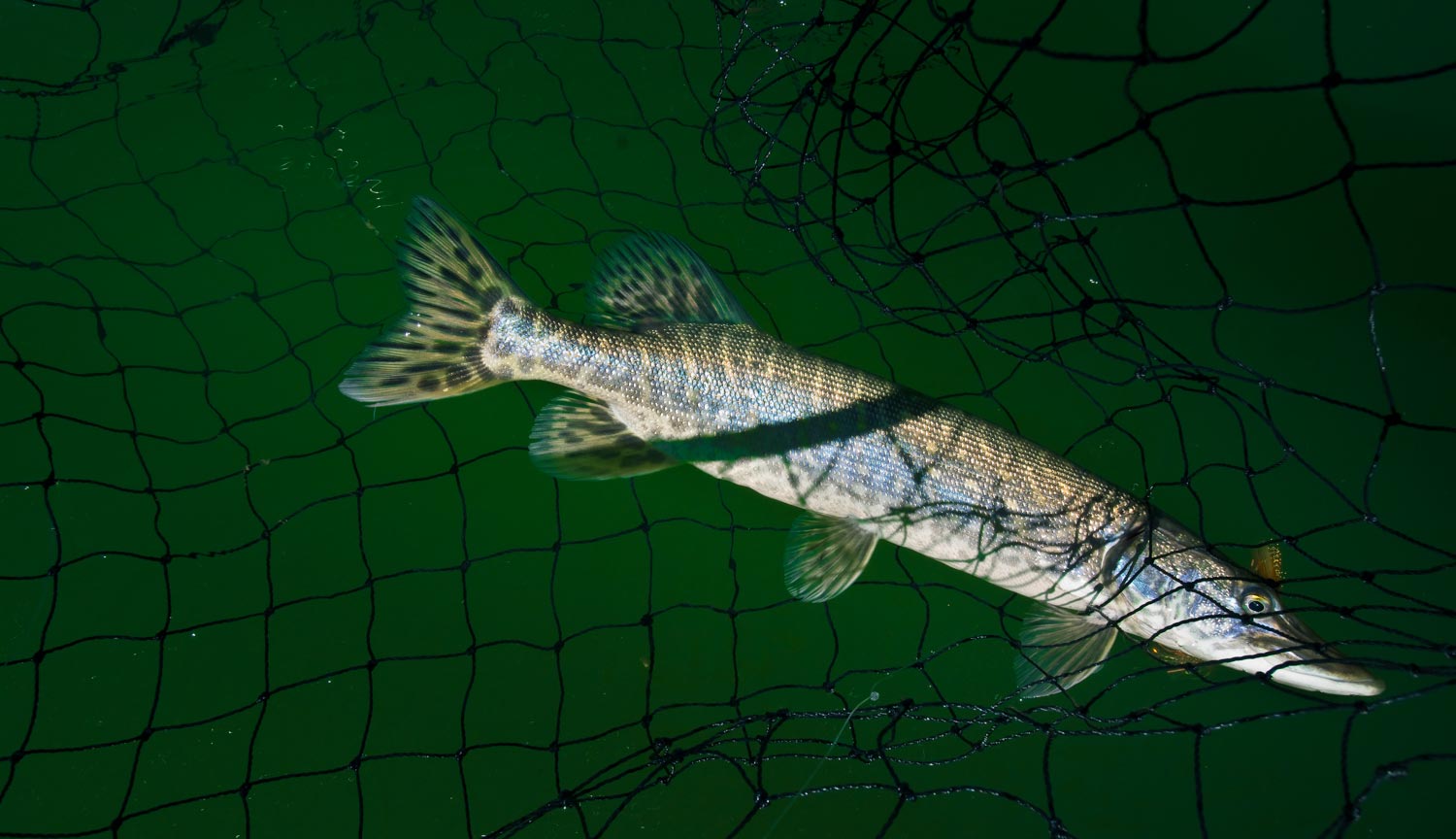
By Jason Tucker
“One sunny afternoon in Labrador.” I love saying that phrase.
One sunny afternoon in Labrador, the dry fly bite for land-locked salmon and brook trout had trailed off to nothing and we were looking for a distraction. We decided to fish for pike.
One of those things you almost never hear about in Labrador is the tremendous pike fishing. The waters are absolutely full of big pike, and when we weren’t targeting them we had to be careful not to toss a streamer into still water, lest it be instantly engulfed by a pike. Every now and then we got surprised in fast water when a pike would dash in from the still water to grab a streamer meant for a big brook trout.
We targeted pike several times during our trip when the fishing got slow. The pike were always willing to entertain, and there were plenty of bays and sloughs in which pike in the six- to fifteen-pound range were stacked up. You could fish for an hour at a time and have a hit or a fish, if not a melee, on every cast without moving location. It was some of the most exciting and memorable fishing of the trip.
We started fishing our streamers on floating lines because the takes were amazing to watch. The fish would zoom out of the depths and crash our streamers on the surface, often coming out of the water in a vicious predatory strike. So on the afternoon in question, we got this brainstorm of doing a photo shoot with mouse flies with the hooks cut off. All we wanted was to get shots of the top-water action and the vicious strikes and aerial maneuvers of the fish, without having to mess around with fighting and unhooking them.
The problem was that it didn’t work.
Read More »3 Tips for Fishing High and Dirty Water for Trout
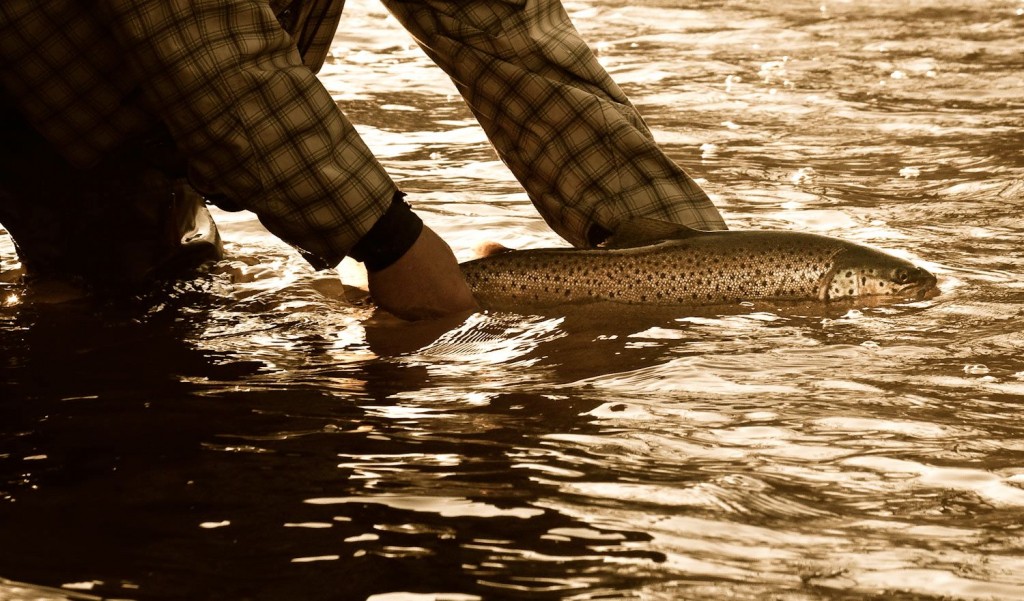
By Kent Klewein
Have you ever pulled up to a stream after a heavy rain, ready to fish, but canceled your fishing plans because the water looked too high and dirty?
I’ll be the first to admit there are times when this is the case, but very often anglers scratch their fishing plans when they should instead, have Fished-ON. The fact is, trout can see a whole lot better than we think, and if you fish the right kinds of fly patterns, and target the right water, in many cases you can do pretty darn good fishing in these water conditions. Even better, your odds at catching a trophy fish are increased, because the dingy water will both mask your approach and keep big educated trout from being able to scrutinize your fly patterns. So go ahead, call those anglers you despise and tell them the waters blown out, and you’ll have a good chance of having the water to yourself and wailing on fish all day long.
Tip 1. Target the Right Kinds of Water
So you’ve decided to take my advice and fish on, good for you. The first thing you need to do when fishing high and dirty water is target high percentage water. I search out the slower moving seams close to the banks, long stretches of fast shallow water that are followed by buckets or deep water where the fish will stack up, and eddies behind boulders or lay downs. These are all safe havens that trout search out refuge in during high water. They all allow trout to save energy by staying out of the excessive current, while capitalizing on the large influx of food sources drifting. Increased flows and rising water increases the amount of food available for trout. Many aquatic insects get flushed off the bottom of the stream, while others emerge from the freshly submerged stream banks. Examples of this are big stoneflies that are normally found hiding away in clumps of debris and under rocks, and cranefly larva that get washed in from the high water flowing along the banks.
Tip 2. Choose Larger and Brighter Fly Patterns
The second thing an angler needs to do to increase their success rate while fishing high and dirty water is choose the right kinds of fly patterns to fish. This is the one time when I feel I don’t have to carry my entire arsenal of gear. I’ll gladly leave my fly boxes with all my tiny fly patterns and light tippet spools at the vehicle. I’ll rig up a 9′-12′ 3x-4x fluorocarbon leader and carry only my fly boxes with large nymphs, bright attractors (eggs and san juan worms), and streamers. What ever you do, don’t be afraid to go big with your fly selection. For instance, larger than average egg patterns work really well in dirty water. The larger profile and bright colors allow the fish to pick them up quickly in the low water clarity. I also like to use
Wild Steelhead on the Menu?
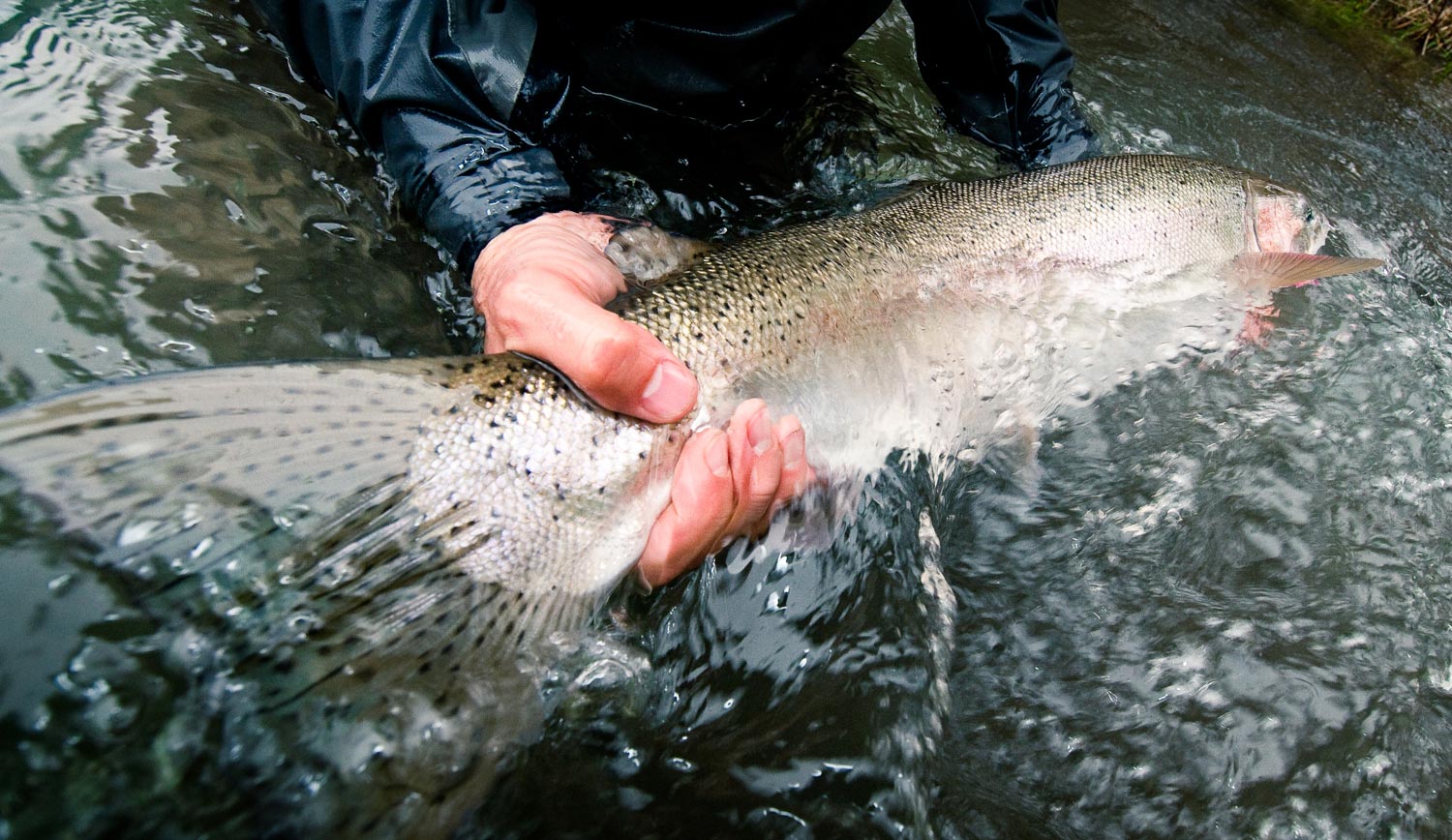
By Alex Lovett-Woodsum
The latest assault on our fisheries? Seafood Watch recommends eating wild OP steelhead.
In the latest of a series of truly baffling assaults on our country’s precious natural resources, Seafood Watch—a program initiated by the Monterey Bay Aquarium to encourage responsible consumer seafood choices—just placed tribally harvested wild Olympic Peninsula steelhead on its list of “good alternative” seafood choices. The decision is being widely condemned by conservation organizations like The Conservation Angler (TCA), an organization working to protect and conserve wild salmon and steelhead across the Pacific Rim, as well as anglers around the country. With current wild steelhead populations representing just 15-20% of recent (1960s) abundance, and OP wild steelhead meeting zero of Seafood Watch’s ten specific criteria for inclusion on the list, the decision has left conservationists and anglers shaking their heads in dismay. The precedent this decision sets is also alarming.
Concerned consumers trust organizations like Seafood Watch to recommend responsible seafood choices based on their supposedly very stringent standards and criteria. In a world where fisheries are under constant threat, people need reliable resources to help them make informed choices. Most want to do the right thing, but sustainable seafood can be a confusing realm to navigate. Seafood Watch’s decision is particularly alarming because so many listen to their advice unquestioningly. And while they claim to base decisions on rigorous criteria and sound science, there is absolutely no legitimate scientific basis for their decision to make OP wild steelhead a “good choice”, and an overwhelming pile of evidence as to why it’s such an appallingly bad idea.
Seafood Watch has seriously undermined
Read More »Sunday Classic / Trout Deformities

I SPOTTED THIS LITTLE GUY IN A HATCHERY SUPPORTED STREAM IN NORTH CAROLINA AND FISHED TO HIM UNTIL I CAUGHT HIM SO I COULD GET A PHOTO.
While not common exactly, deformities like this are not unusual in either hatcheries or in the wild but you seldom see a ‘special’ fish like this in a wild stream. Nature deals with this sort of thing in short order. In a hatchery, however, a fish like this will do fine and grow to maturity.
This brook trout would have been a solid 16 inches if he were normal. A buddy suggested I bank him. There was no need. This kind of deformity stems from injury to the fish’s spine early in life. There are no defective genes or disease to pass along so I released him. After all, he plays an important role in the ecosystem, at least from the otter’s perspective.
There can certainly be problems with hatchery raised fish. Disease and poor genetics can wreak havoc on wild populations. On the whole, I think North Carolina does a good job and it’s important to remember that this is a regional issue that is best evaluated by region. What’s right for a trout stream in North Carolina is not right for a steelhead river in Oregon. That’s another topic worth some considerable ink, but not just now.
It did get me thinking about some more troubling fish deformities. Specifically Idaho’s two-headed trout. There was a little bit of excitement about it when the New York Times published photos, in February of 2012, of the deformed fish which were
Read More »Saturday Shoutout / A Little Humility
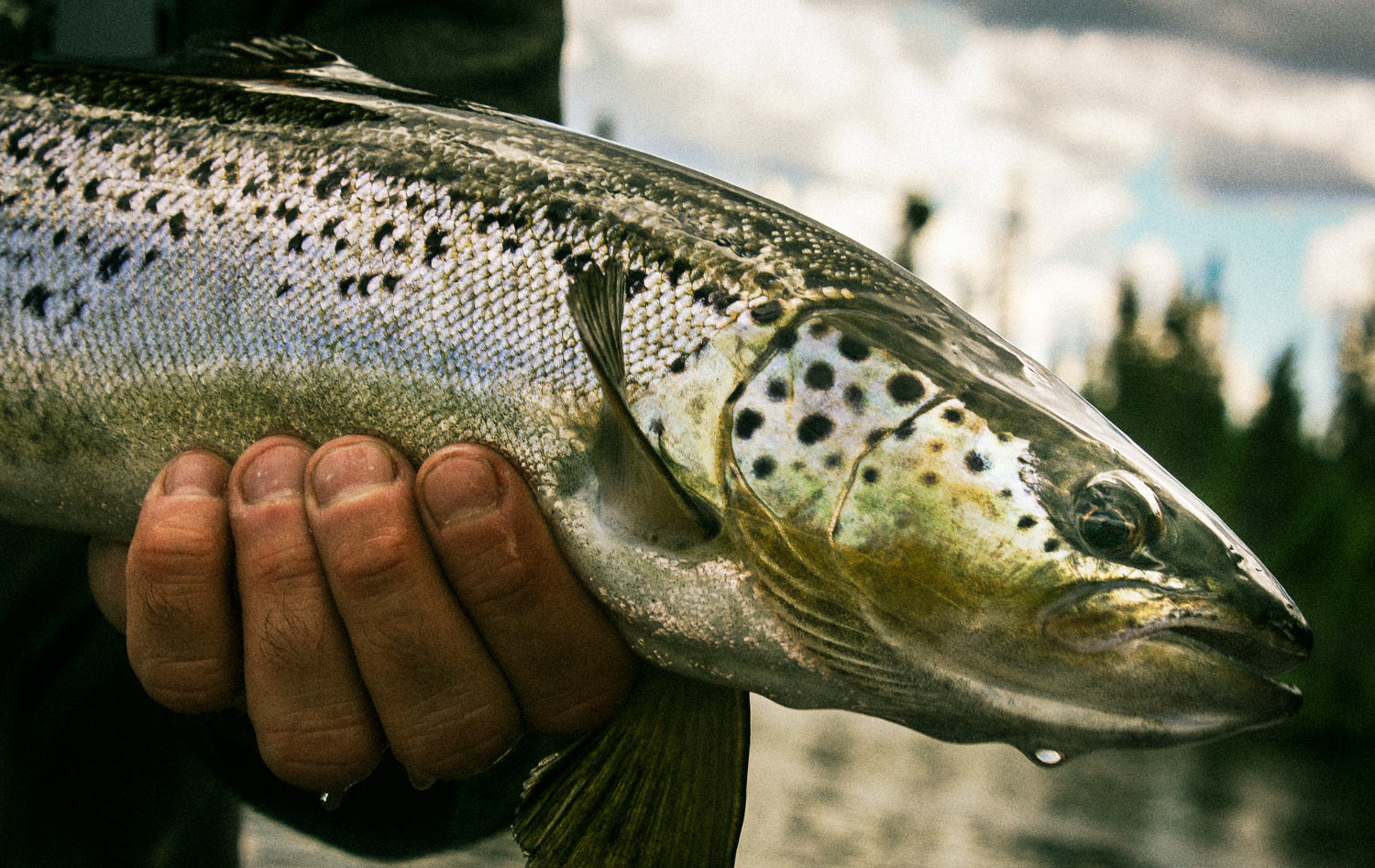
Is it possible we are all a little hypocritical from time to time.
I couldn’t resist sharing this article, because it kind of struck home. Honestly, I thought it may have been written for my benefit. Enough so that I offered an apology for something I’d said to a friend with the best of intentions. Turns out my fears were ungrounded, but it made me think.
My friend Jason Tucker has a way of stepping back from a situation, which I sometimes lack. In this instance he turned my own philosophy upside down. I have strong feelings on catch-and-release, and I stand by them, but this made me think. You should give it a look.
A LITTLE HUMILITY
Read More »Stacking Running Line For Better Spey Casting: Video
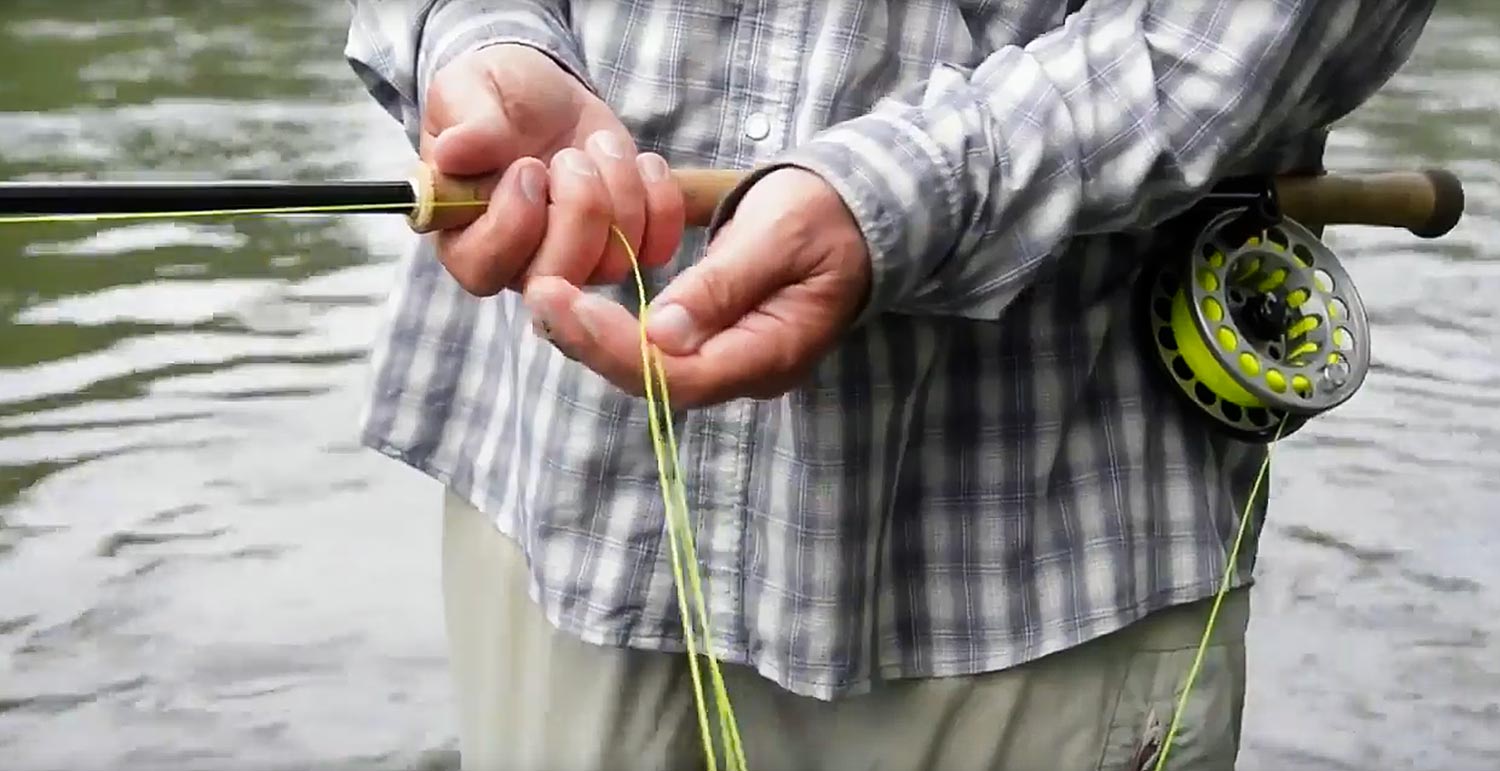
How do you shoot a hundred feet of running line without a tangle?
It’s easier than it sounds. There’s a very specific technique for stacking running line when spey casting. When it’s done right, everything comes off without a hitch. If you are learning to cast two-hand rods, it’s a skill you’ll need to learn pretty quickly. It’s challenging to write about, so here’s a video, which should make it pretty clear.
WATCH THE VIDEO AND LEARN TO STACK LINE FOR BETTER SPEY CASTING.
Read More »Bahamas Fishing Regulations: What’s Really Happening
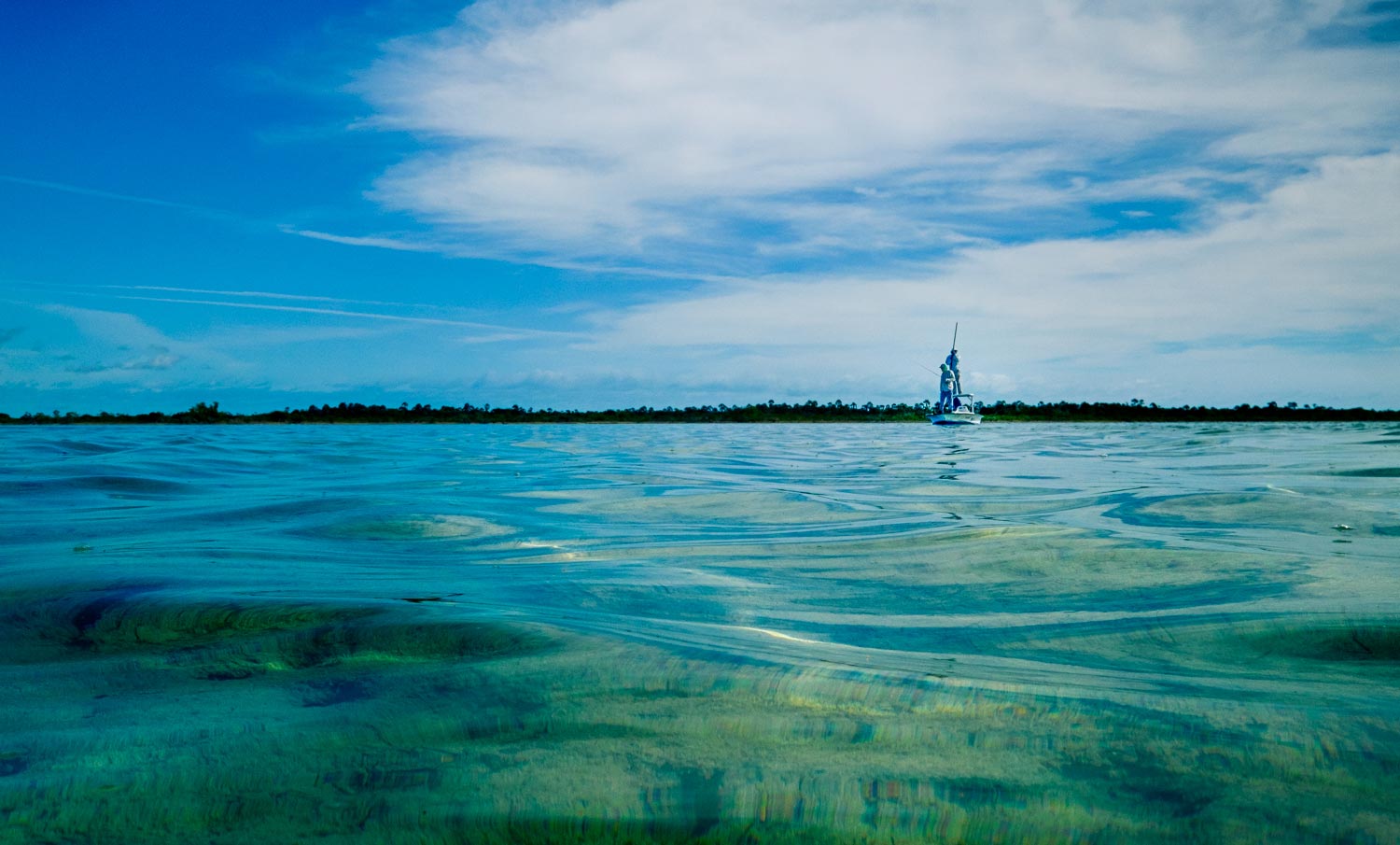
As of January 19, 2017, new Bahamian fishing regulations are in effect and confusing both anglers and authorities.
I was recently on South Andros for the G&G Bonefish school and our group was the first to be issued Bahamian fishing licenses on the island. Implementation is a little messy but flats fishing in the Bahamas is operating as usual.
Here’s what you need to know about the new Bahamian flats fishing regulations.
Who does it affect?
The great majority of anglers will see no real difference fishing under these regulations. You will be required to buy a license ($20/week, $60/year), and for the time being, buying that license is a little cumbersome, but it’s very inexpensive. Anglers fishing with lodges or independent guides can count on help getting their licenses. DIY anglers will have to get licenses on their own, and will be restricted to wade fishing or single-person water craft.
There are only two groups who are really negatively impacted by the regulation. Anglers who DIY fish with a boat. Folks who, for example, own a second home in the Bahamas and have a boat, will have to hire a guide. That’s silly but it’s the law. Still, that’s a small group of anglers and if you are one of them I’d suggest you get busy organizing and lobbying for a change in the law. The other group negatively impacted are the guides themselves. All guides now have to pay a $150/year license fee, which they are not happy about. Interesting for a law which was supposed to support guides. If you are not in one of these two groups, once you have your license, the new regulations will not affect you.
How do you get a Bahamian fishing license?
This is where it gets tricky. The new law was put into effect without any mechanism to fulfill license applications. There will eventually be an online license site, but for now the process is quite cumbersome. When I landed on South Andros, even the local officials had no idea the law was in effect. This meant two things:
Read More »3 Ways to Improve Your Fly Casting on the Flats

About ten years ago, I embarked on my first international saltwater fly fishing trip, with a couple Texas boys I’d previously met while chasing peacock bass in the Amazon. The saltwater trip took place down in Mexico, specifically the Ascension Bay area. Our primary target fish were bonefish but we kept a constant lookout for permit and tarpon. The two born and raised Texas boys had grown up fly fishing in the salt, and they both had more than enough testosterone, ego and skill to handle the demanding fishing conditions. I on the other hand, had never experienced first hand the difficulties that saltwater fly fishing brings. I really struggled with spotting fish in an unfamiliar environment and managing my presentations in 25 mph winds. I’ll never forget the humbling feeling of defeat after our first day of fly fishing on the flats. My counterparts landed a dozen bonefish a piece while I only managed to catch one. Just about the entire trip I was plagued with the feeling of being under-gunned on the water. The wind totally kicked my butt and I missed numerous opportunities because I couldn’t cast far enough to consistently get my fly to the targets my guide was calling out.
At the time, the only problem I saw in my fly casting was I didn’t seem to have nearly as much power in my casting stroke as my buddies. That was true, but the real problem was I didn’t have the competency to diagnose what I was doing wrong and neither of my buddied did either. All they kept saying, over and over to me, was that I needed to work on my double-haul.
Read More »Pay to Play
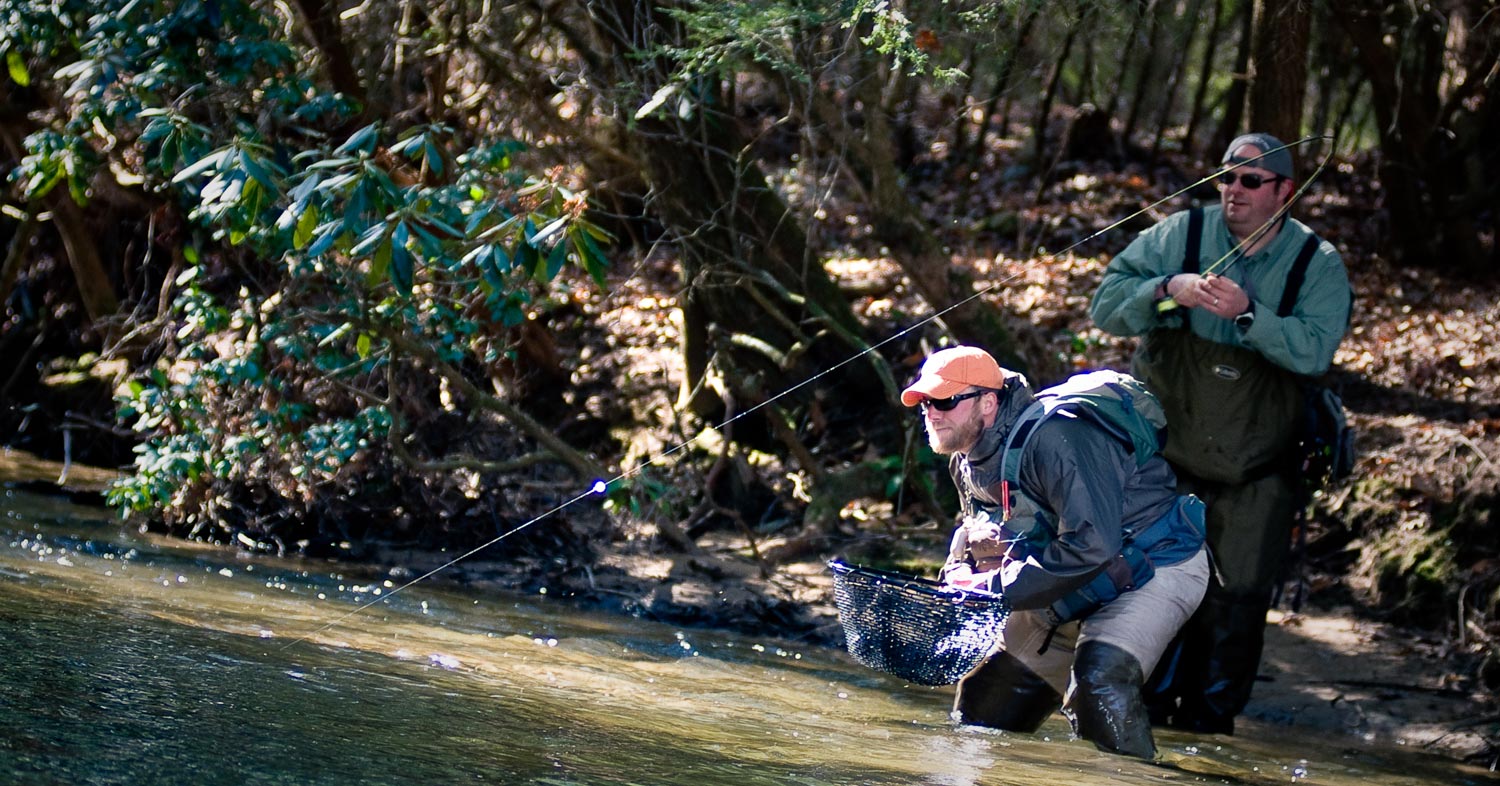
Something a little different this morning…
I’d like to have a friendly discussion with you, our readers, about something that I’ve noticed popping up on social media more frequently than I can remember happening in recent past. Over the past few weeks, I’ve caught a handful of posts, either an article or a video, that showcases an angler grinning ear-to-ear while holding a slab of a rainbow or brown trout that he or she just caught on a private, “pay to play” piece of water. Good for them, right? Well, some of the comments that have been posted and shared in response to some of these photos and videos might lead you to think that these anglers have made a deal with the devil and forsaken all that is holy in the world of fly fishing. Now, I can certainly understand some of the negative feelings that some anglers might have towards privately held and stocked sections of water that often require deeper pockets in order to fish their kempt waters, if they allow access to the public at all.
There are all sorts of private, “pay to play” waters that exist across the country. My home state. The Southeast. Throughout the Western states. Everywhere. And it’s not even limited to just trout fishing. There’s a small lake just down the road from my house that’s locally known for producing monster bass. You can fish there too as long as you can pony up $12,000 for the initial membership fee and monthly payments of $150. Places like these have been around for a long, long time, and there is no doubt they’ll be around as long as there is enough water for fish to swim.
I’m not writing this article as a way to call anyone out or “bash” these opinions in any way, nor do I think they are completely wrong. This isn’t about hurt feelings or defending anybody. I’m more curious about the rationale behind the reactions and opinions. The anglers that oppose private water, just like everyone else, are entitled to their own opinions and beliefs. I think we all would agree that there’s nothing
Read More »